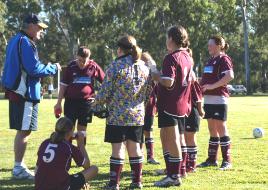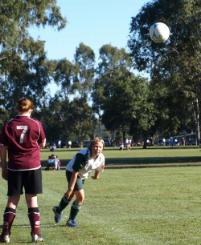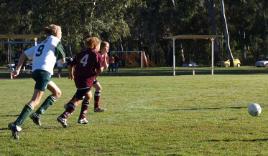Footballing females no longer out in the cold
Published on 18 August, 2008
The Football Federation of Australia (FFA) plans to make Australia the world leader in women's football by 2019.
And that challenge begins now. student reporter Jen Klower takes up the story ...

.... For the first time in its history, 2008 saw the FFA separate the genders.The face of football has changed and the ambition is to be realized through regional development.
The nationwide program gives the FFA 10 years to realise FIFA president Sepp Blatter's prediction that "the future is female".
Central Queensland is well positioned to achieve that ambition.
As local clubs get down to the season's business, Rockhampton's home of football, Norbridge Park, shows that business to be anything but usual. Traditional mixed teams have been replaced by youth segregation.
Regional Development Officer for Rockhampton and District Soccer Federation (RDSF), Washington Gonzales has championed FFA's goal to develop girls on their own terms.
Mr Gonzales said the major difference is "girls live in reality, boys in dreams".
"As coaches tend to concentrate on boys' development, girls become frustrated, lose interest and registrations fall."

Mr Gonzales further stated that "as girls are more mature it's possible to teach proper technique at the proper age".
Developing girls separately is already a success as Mr Gonzales added "from our zone (CQ), 5 under 13 girls have already been selected for state youth titles".
Without the benefit of mainstream media coverage and lucrative sponsorship the women's game has already outstripped the men's in achievement.
Aussie women are currently dominating the Asian Champions league with the Matildas, the female equivalent of the Socceroos, ranked 3rd in the world.
Comparing the success between the sexes shows football's future could well be realised in the female form.
The realism that Mr Gonzales credits the girls when "boys imagine playing for Liverpool, girls are more realistic" is possibly due to the lack of examples.
Previously women's football has been shunned by the media, until now.

Recognition for the female game has come slowly but on the strength of the success of the Hyundai A-league the FFA introduced a female version in 2007.
Participation and crowd attendance at the games last year came as no surprise to Sydney FC Women's Coach, Alen Stajcic, who confirmed women's football as the "fastest growing sport in the 2000s" with over 84,000 registered youth players.
With $32m in federal funding and the ABC scheduled to broadcast the 2008 seasons, footballing female youth are to receive prime time exposure of the elite examples.
This is an achievement in itself in the face of Australia's sporting culture where the only sport women have in which to aspire is netball.
Traditional Aussie sports disregard the female once they hit puberty. Then it's on to the serious stuff that allows no room for girls over the age of 12.
AFL, rugby, cricket and basketball all provide for girls until they reach the age of 13. At the serious end of the development process or, as soon as they hit puberty, they're out the door.
The FFA on the other hand is currently establishing centres of excellence for 10-14 year old girls. These mini academies set out to find the elite amongst them, resulting in a week-long intensive training camp.
Rocky girls will square up against the academies from the rest of Queensland for the prize of competing in state titles and a spot in the Queensland Academy of Sport (QAS).
Yet that glory is far from the girls' minds on a cold, wet winter's morning. They're first to arrive at Norbridge Park every Saturday, not to be the next best great or to dream of playing for the rich clubs of Europe.
They're there to win a game of football.

